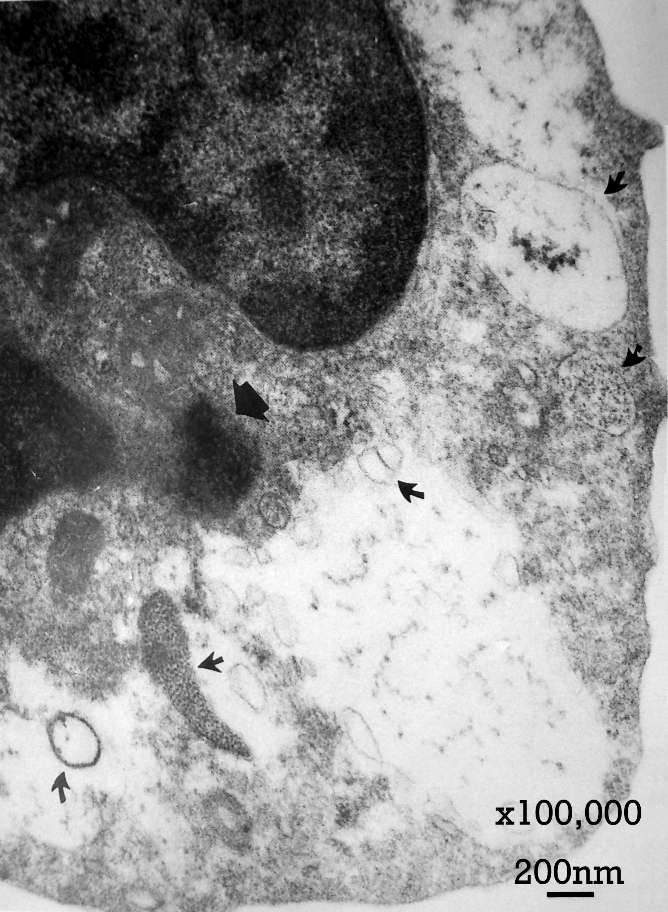Intracellular Bacterial Biofilm-Like Pods in Urinary Tract Infections -- Anderson et al. 301 (5629): 105 -- Science: "Intracellular Bacterial Biofilm-Like Pods in Urinary Tract Infections
Gregory G. Anderson,1* Joseph J. Palermo,1* Joel D. Schilling,1 Robyn Roth,2 John Heuser,2 Scott J. Hultgren1"
Tuesday, August 7, 2007
Thursday, July 5, 2007
ScienceDaily: Encyclopedia Of DNA: New Findings Challenge Established Views On Human Genome
ScienceDaily: Encyclopedia Of DNA: New Findings Challenge Established Views On Human Genome: "Encyclopedia Of DNA: New Findings Challenge Established Views On Human Genome"
Wednesday, May 30, 2007
Nanobacteria, Cell Wall Deficient Forms
This is an older pdf from Milton Wainwright which gives a beautiful introduction to the wonderfully suppressed world of tiny pleiomorphic bacteria, Cell wall deficient forms, viruses, L-forms, nanobacteria, whatever the hell you want to call the phenomena.
http://mic.sgmjournals.org/cgi/reprint/145/10/2623.pdf
It's a shame how undeveloped the biology is in this field. However, the Marshall Protocol offers chronic disease sufferers an easy way to acknowledge CWD forms and follow a rigorous Th1 protocol to full remission. There are earlier blog posts here with much evidence concerning these forms.
http://mic.sgmjournals.org/cgi/reprint/145/10/2623.pdf
It's a shame how undeveloped the biology is in this field. However, the Marshall Protocol offers chronic disease sufferers an easy way to acknowledge CWD forms and follow a rigorous Th1 protocol to full remission. There are earlier blog posts here with much evidence concerning these forms.
Wednesday, May 23, 2007
ScienceDaily: Resistance Genes In Our Food Supply
ScienceDaily: Resistance Genes In Our Food Supply: "Resistance Genes In Our Food Supply"
Plus, it's way worse than this.
Plus, it's way worse than this.
Monday, May 14, 2007
ScienceDaily: DOE JGI Sets 'Gold Standard' For Metagenomic Data Analysis
ScienceDaily: DOE JGI Sets 'Gold Standard' For Metagenomic Data Analysis
My own feelings about microbial communities are very hard to characterize. "Gene-swapping collectives," "DNA pea soup" are a couple of phrases which describe this complex environment. This news article about the DOE comes as an advancement in genomics to help compute sequences and structures, make sense of the total mess of a storm microbes eventually attain in a chronic environment, and validate those findings.
My own feelings about microbial communities are very hard to characterize. "Gene-swapping collectives," "DNA pea soup" are a couple of phrases which describe this complex environment. This news article about the DOE comes as an advancement in genomics to help compute sequences and structures, make sense of the total mess of a storm microbes eventually attain in a chronic environment, and validate those findings.
Friday, May 4, 2007
Quorom Sensing
Bonnie L. Bassler: "Cell-to-Cell Communication in Bacteria Cell-to-Cell Communication in Bacteria "
Quorom Sensing 'Wikipedia'.....
and a news article that may put things into context a little....
Fighting Bacteria By Preventing Them From Talking To Each Other
Quorom Sensing 'Wikipedia'.....
and a news article that may put things into context a little....
Fighting Bacteria By Preventing Them From Talking To Each Other
Thursday, April 5, 2007
Metagenomics, and the blurring of Species...
Metagenomics, and the blurring of Species... - Dr Marshall's Perspective - DR MARSHALL'S PERSPECTIVE - THE MARSHALL PROTOCOL:
"The American Society for Microbiology has released a new (FREE) document
'Reconciling Microbial Systematics and Genomics,' March 2007
which explains in detail how pathogens engage in lateral transfer of DNA (and other miscellany) to morph into species which can no longer be readily regarded as distinct. Another older document from the same source is
'Microbial Triggers of Chronic Human Illness,' April 2005
Which we have seen before, but is worth review now. Especially the summary of 'problems' starting on page 9. Enjoy!
ps: I totally agree with this passage:
The criteria used to ascribe etiology to non-microbial causes like genetics and non-infectious environmental influences are far less rigorous than those applied to identify microbial causes. For example, the autism community has all but concluded that autism is a genetic disease, but the dizygotic twin and sibling concordance studies do not support a dominant role for genetic cause. These potential etiologies need to be held to the same experimental standards for causation as microbial etiologies."
"The American Society for Microbiology has released a new (FREE) document
'Reconciling Microbial Systematics and Genomics,' March 2007
which explains in detail how pathogens engage in lateral transfer of DNA (and other miscellany) to morph into species which can no longer be readily regarded as distinct. Another older document from the same source is
'Microbial Triggers of Chronic Human Illness,' April 2005
Which we have seen before, but is worth review now. Especially the summary of 'problems' starting on page 9. Enjoy!
ps: I totally agree with this passage:
The criteria used to ascribe etiology to non-microbial causes like genetics and non-infectious environmental influences are far less rigorous than those applied to identify microbial causes. For example, the autism community has all but concluded that autism is a genetic disease, but the dizygotic twin and sibling concordance studies do not support a dominant role for genetic cause. These potential etiologies need to be held to the same experimental standards for causation as microbial etiologies."
Monday, March 26, 2007
The Science Creative Quarterly » CATIONIC PEPTIDES: A NEW HOPE
.gif)
The Science Creative Quarterly » CATIONIC PEPTIDES: A NEW HOPE: "CATIONIC PEPTIDES: A NEW HOPE
By Sara Wilcox"
By Sara Wilcox"
Peptide Promise
Video from The Leading Edge
Inimex Product Candidate is First Immune Defense Regulator to Cure Infections Without Causing Harmful Inflammation.
Info on cationic antimicrobial peptides from R.E.W. Hancock labs.
Inimex Product Candidate is First Immune Defense Regulator to Cure Infections Without Causing Harmful Inflammation.
Info on cationic antimicrobial peptides from R.E.W. Hancock labs.
Tuesday, March 20, 2007
Dr. Andrew Wright
Sunday, March 11, 2007
Sex, Cancer And The Mandatory HPV Vaccine
Sex, Cancer And The Mandatory HPV Vaccine:
"Sex, Cancer And The Mandatory HPV Vaccine By Alan Cantwell, MD
©. 2007 All Rights Reserved 2-28-7"
F'ing vaccines! We live in a messed up medical world, driven by $hite. I read "The Cancer Microbe" over last summer. I also read Lida Mattman's "Stealth Pathogens.....". What is wrong with the Cancer machine? Don't they understand the complex interaction between communites of bacteria, viruses and God knows what else? I guess, they just don't want to understand. Selfishness is harmful.
Do me a favor and never get a vaccine unless it's the freakin bubonic plague or something insanely stupid.
"Sex, Cancer And The Mandatory HPV Vaccine By Alan Cantwell, MD
©. 2007 All Rights Reserved 2-28-7"
F'ing vaccines! We live in a messed up medical world, driven by $hite. I read "The Cancer Microbe" over last summer. I also read Lida Mattman's "Stealth Pathogens.....". What is wrong with the Cancer machine? Don't they understand the complex interaction between communites of bacteria, viruses and God knows what else? I guess, they just don't want to understand. Selfishness is harmful.
Do me a favor and never get a vaccine unless it's the freakin bubonic plague or something insanely stupid.
Thursday, March 1, 2007
"The skin is home to a virtual zoo of bacteria"
The most numerous cells in our body are microbial—they outnumber our cells 10 to 1. The body has microbes native to the body, including the skin, and these populations change according to how we live, he says. "Ultimately what we want to do is compare disease and health," says Dr. Blaser. Keeping bacterial populations in our body stable may be part of staying healthy, he says.
10 to 1........hmmm. Then add the gut, CFS, brain, etc...and gene transfer. Wow. It's like a microcosm that's complicated as hell.
10 to 1........hmmm. Then add the gut, CFS, brain, etc...and gene transfer. Wow. It's like a microcosm that's complicated as hell.
Cell Wall Deficient Forms: Stealth Pathogens,... - Google Book Search
This is a very nice text book on the subject of staining techniques used to identify cell wall deficient pathogens. Heavy read, but it lets you know as to the extent inflammatory process lead to chronic disease and cancer forms.
Cell Wall Deficient Forms: Stealth Pathogens,... - Google Book Search: "Numerous infectious diseases are currently described as idiopathic, meaning that 'the cause is a complete mystery.' For many idiopathic diseases, the causes become clear when certain techniques are applied to the patient's blood or other tissues. Cell Wall Deficient Forms: Stealth Pathogens, Third Edition describes these techniques."
Cell Wall Deficient Forms: Stealth Pathogens,... - Google Book Search: "Numerous infectious diseases are currently described as idiopathic, meaning that 'the cause is a complete mystery.' For many idiopathic diseases, the causes become clear when certain techniques are applied to the patient's blood or other tissues. Cell Wall Deficient Forms: Stealth Pathogens, Third Edition describes these techniques."
Dr. Brett Finlay
I'm intrigued with Dr. Finlay's research. Innate immunity is the key to recovery from chronic disease. He focuses on intracellular pathogens including Salmonella and E.coli bacteria and innate immunity.
Finlay at the University of British Colombia
Website
These are some of my favorite "free" publications:
Crossing the Line: Selection and Evolution
of Virulence Traits
PHAGOCYTE SABOTAGE: DISRUPTION
OF MACROPHAGE SIGNALLING BY
BACTERIAL PATHOGENS (apparently incomplete description)
Evidence of a Large Novel Gene Pool
Associated with Prokaryotic Genomic Islands
Finlay at the University of British Colombia
Website
These are some of my favorite "free" publications:
Crossing the Line: Selection and Evolution
of Virulence Traits
PHAGOCYTE SABOTAGE: DISRUPTION
OF MACROPHAGE SIGNALLING BY
BACTERIAL PATHOGENS (apparently incomplete description)
Evidence of a Large Novel Gene Pool
Associated with Prokaryotic Genomic Islands
The European Micro Biology Laboratory (EMBL) and molecular machines

I very much like the works of the Frangakis Group. I've come across the website for The Structural and Computational Biology Unit at EMBL. "The Structural and Computational Biology Unit pursues a few common large projects, such as trying to obtain a cell at molecular resolution, that require the input of the different skill sets in the Unit. At the same time it advances science in the different science disciplines it unites." Electron microscopy has come a long way over the past 20 years. The ability to integrate mulitple means of detection into one image is a powerful tool. Hopefully one day these guys will look at cell wall deficient forms and the like.
This work correlates to 'Technologies for the characterization and imaging of molecular machines' objective set out by the DOE Genomics: GTL departement. Being an engineer, I love machines and visualizing them.
Role of L-Forms of Nocardia caviae in the Development...
Role of L-Forms of Nocardia caviae in the Development of Chronic Mycetomas in Normal and mmunodeficient Murine Models.
Some interesting pictures. There are a couple of nasties too.
Some interesting pictures. There are a couple of nasties too.
Mycoplasma-like Organisms and Opthalmic Disease
Part of the Wirostko studies in the late 1980's. Unfortunately, I don't have any publication subscriptions and don't have access to many pictures.
Mycoplasma-like Organisms and Opthalmic Disease
I have linked to another photo here. There are others including Lida Mattman who understand the difficult-to-cultrure-and-isolate pleomorphic forms. Reminds me of quantum mechanics not being able to pin-point a specific quantity without interfering and consequently altering the outcome.
Mycoplasma-like Organisms and Opthalmic Disease
I have linked to another photo here. There are others including Lida Mattman who understand the difficult-to-cultrure-and-isolate pleomorphic forms. Reminds me of quantum mechanics not being able to pin-point a specific quantity without interfering and consequently altering the outcome.
Mycoplasma-like Organisms and Opthalmic Disease

Part of the Wirostko studies in the late 1980's. Unfortunately, I don't have any publication subscriptions and don't have access to more electron microscope pictures.
This paper below has some interesting pictures and notes.
Mycoplasma-like Organisms and Opthalmic Disease
Mycoplasma-like Organisms and Opthalmic Disease
CWD bacteria (picture from above).
Subscribe to:
Posts (Atom)

